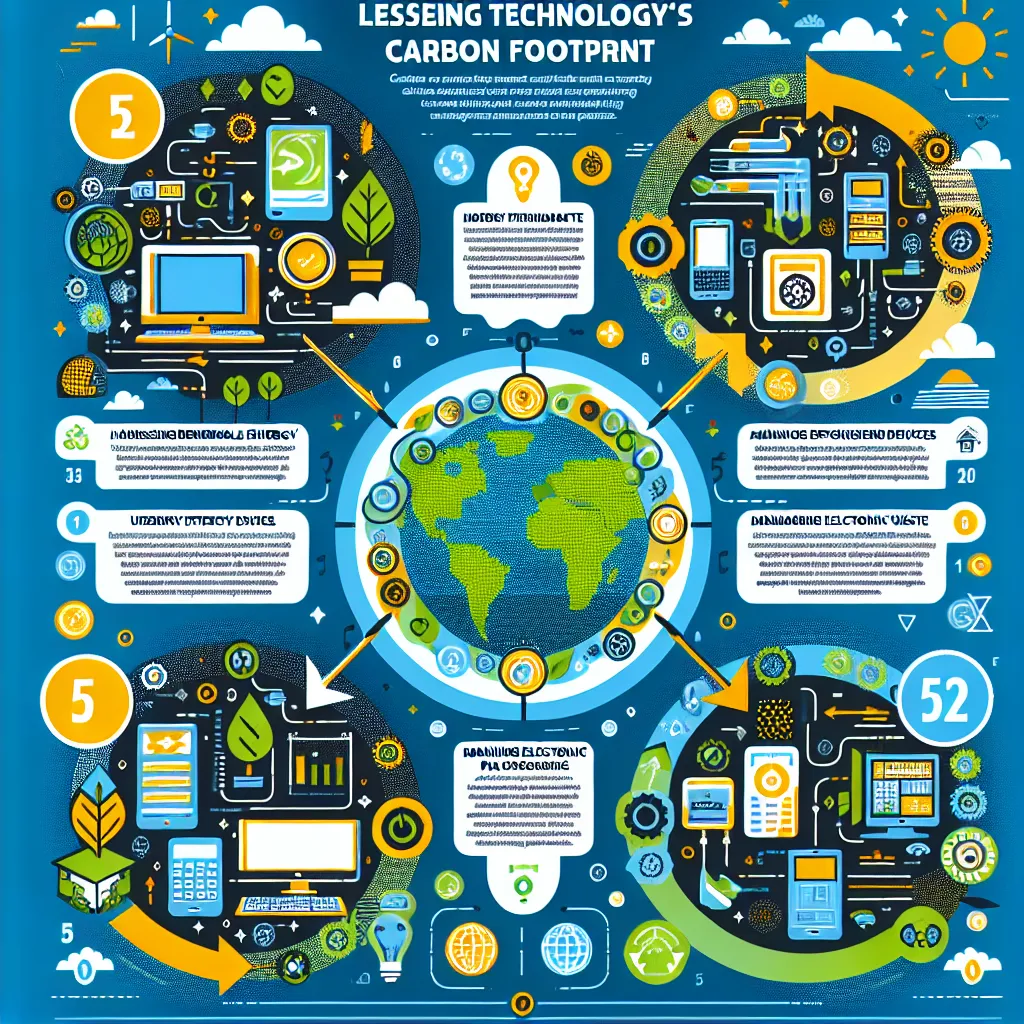Technology plays a crucial role in our modern world, but it also contributes significantly to carbon emissions. As a result, the topic of reducing the carbon footprint of technology has become increasingly important in IELTS Writing Task 2 essays. This article will provide you with sample essays and expert analysis to help you tackle this subject effectively in your IELTS exam.
Nội dung bài viết
Based on recent trends and past exam questions, we can expect to see more questions related to technology and its environmental impact in future IELTS tests. Let’s examine a relevant question that has appeared in recent exams:
Some people believe that technological advancements have increased carbon emissions and environmental damage. To what extent do you agree or disagree with this statement? What measures can be taken to reduce the carbon footprint of technology?
Analyzing the Question
This question consists of two parts:
- Your opinion on whether technological advancements have increased carbon emissions and environmental damage.
- Measures to reduce the carbon footprint of technology.
To answer this question effectively, you need to:
- Clearly state your position on the first part of the question.
- Provide reasons and examples to support your view.
- Suggest practical measures to reduce technology’s carbon footprint.
- Ensure a balanced discussion of both aspects of the question.
Sample Essay 1 (Band 8-9)
Technological advancements have undoubtedly contributed to increased carbon emissions and environmental damage in recent decades. However, I believe that technology also holds the key to mitigating these issues. This essay will discuss the environmental impact of technology and propose measures to reduce its carbon footprint.
It is undeniable that the rapid proliferation of technology has led to increased energy consumption and carbon emissions. The production, use, and disposal of electronic devices contribute significantly to greenhouse gas emissions. For instance, data centers, which power our digital world, consume vast amounts of electricity, often generated from fossil fuels. Moreover, the constant upgrade cycle of consumer electronics results in massive e-waste, further exacerbating environmental problems.
However, it is crucial to recognize that technology also offers solutions to these challenges. Innovations in renewable energy, energy-efficient devices, and smart grid systems have the potential to significantly reduce our carbon footprint. For example, advancements in solar panel efficiency and battery storage technology are making clean energy more accessible and affordable.
To reduce the carbon footprint of technology, several measures can be implemented. Firstly, governments and corporations should invest heavily in research and development of green technologies. This includes improving the energy efficiency of devices and developing more sustainable manufacturing processes. Secondly, implementing stricter regulations on e-waste management and promoting circular economy principles can minimize the environmental impact of electronic waste.
Additionally, individuals can play a crucial role by making more sustainable choices. This includes using devices for longer periods before upgrading, opting for energy-efficient appliances, and properly recycling electronic waste. Furthermore, consumers can support companies that prioritize sustainability in their product design and manufacturing processes.
In conclusion, while technological advancements have contributed to environmental challenges, they also offer promising solutions. By implementing a combination of policy measures, corporate responsibility, and individual actions, we can harness the power of technology to reduce its carbon footprint and create a more sustainable future.
(Word count: 309)
 Reducing carbon footprint of technology
Reducing carbon footprint of technology
Sample Essay 2 (Band 6-7)
In recent years, many people have become concerned about the impact of technology on the environment. While it’s true that technological advancements have contributed to increased carbon emissions, I believe that technology can also be part of the solution. In this essay, I will discuss my views on this issue and suggest some ways to reduce the carbon footprint of technology.
It’s clear that the growth of technology has led to higher energy consumption and more pollution. For example, the production of smartphones and computers requires a lot of resources and energy, which can harm the environment. Also, the increasing use of data centers for cloud computing and internet services consumes a huge amount of electricity, often from fossil fuels.
However, technology is also helping us find ways to protect the environment. Many new inventions are focused on creating clean energy and reducing waste. For instance, solar panels and wind turbines are becoming more efficient and affordable, thanks to technological improvements. This helps us reduce our dependence on fossil fuels and lower carbon emissions.
To reduce the carbon footprint of technology, we can take several steps. First, companies should focus on making devices that last longer and are easier to repair. This would reduce the need for frequent replacements and cut down on electronic waste. Second, governments should encourage the use of renewable energy sources for powering technology infrastructure, like data centers.
Individuals can also make a difference by using their devices more responsibly. This includes turning off electronics when not in use, choosing energy-efficient products, and recycling old devices properly. Additionally, people can support companies that prioritize environmental sustainability in their technology products.
In conclusion, while technology has contributed to environmental problems, it also offers solutions. By taking action at both the individual and societal levels, we can harness the power of technology to create a more sustainable future and reduce its carbon footprint.
(Word count: 305)
Writing Tips for This Topic
-
Vocabulary: Use a range of environmental and technological terms accurately. For higher band scores, incorporate more sophisticated vocabulary related to sustainability and innovation.
-
Grammar: Employ a mix of simple and complex sentence structures. For band 8-9, use advanced grammatical constructions such as inversions and cleft sentences.
-
Coherence and Cohesion: Ensure smooth transitions between paragraphs and ideas. Use a variety of linking words and phrases appropriate to your band level.
-
Task Response: Address all parts of the question fully. For higher scores, provide a nuanced perspective on the issue, considering multiple viewpoints.
-
Examples: Use specific, relevant examples to support your arguments. Higher band essays should include more detailed and varied examples.
Key Vocabulary to Remember
-
Carbon footprint (noun) – /ˈkɑːrbən ˈfʊtprɪnt/ – The amount of carbon dioxide released into the atmosphere as a result of the activities of a particular individual, organization, or community.
-
Sustainable (adjective) – /səˈsteɪnəbl/ – Able to be maintained at a certain rate or level without depleting natural resources or causing ecological damage.
-
Renewable energy (noun phrase) – /rɪˈnjuːəbl ˈenədʒi/ – Energy from a source that is not depleted when used, such as wind or solar power.
-
E-waste (noun) – /ˈiː weɪst/ – Discarded electrical or electronic devices.
-
Energy-efficient (adjective) – /ˈenədʒi ɪˈfɪʃnt/ – Using less energy to provide the same level of energy service.
-
Circular economy (noun phrase) – /ˈsɜːkjələr iˈkɒnəmi/ – An economic system aimed at eliminating waste and the continual use of resources.
-
Smart grid (noun phrase) – /smɑːrt ɡrɪd/ – An electricity supply network that uses digital communications technology to detect and react to local changes in usage.
-
Green technology (noun phrase) – /ɡriːn tekˈnɒlədʒi/ – Technology that is environmentally friendly developed and used in a way that conserves natural resources and the environment.
Conclusion
The topic of reducing the carbon footprint of technology is likely to remain relevant in future IELTS Writing Task 2 questions. By understanding the key aspects of this issue and practicing with sample essays like those provided, you can improve your ability to tackle such questions effectively.
To further enhance your skills, try writing your own essay on this topic or related themes such as:
- The role of individual responsibility versus government action in promoting sustainable technology use.
- The impact of emerging technologies on environmental sustainability.
- Balancing technological progress with environmental conservation.
Remember to focus on clear argumentation, relevant examples, and appropriate use of vocabulary and grammar. Feel free to share your practice essays in the comments section below for feedback and discussion with fellow IELTS candidates.
For more insights on related topics, you might find these articles helpful:


